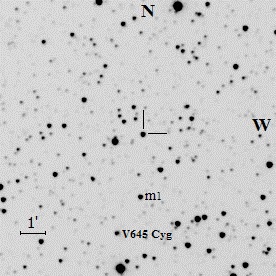| Article in PDF |
"Peremennye Zvezdy", Prilozhenie, vol. 11, N 19 (2011) |
3UC 281-203711: a New Variable with Total Eclipses
S. Gorda, A. Sobolev
Astronomical observatory of Ural State University, Ekaterinburg, Russia
| ISSN 2221–0474 |
Received: 10.02.2011; accepted: 5.05.2011
(E-mail for contact: Stanislav.Gorda@usu.ru)
| ||||||||||||||||||||||
Remarks: |
| The new variable star 3UC 281-203711 was discovered during monitoring the young
irregular variable V645 Cyg at the Astronomical Observatory of the Ural State
University.
The first brightness decrease of 3UC 281-203711, by 0.08 mag, was recorded
on JD 2454966.3.
The AZT-3 reflector (D = 0.45m, F(Newton) = 2.0m) with an Alta-U6 CCD camera (Kodak KAF-1001E, 2048x2048, 24-micron chip) was used. The photometry was carried out using the V and R Cousins/Bessell filters. The uncertainty of our brightness measurements during individual nights was within 0.003–0.007 mag, as estimated by the difference of brightness of the comparison star 3UC 281-203713 and the check star 3UC 281-203646. The reduction of the CCD frames was carried out using MaxIm DL software. Our observations were performed during about 1.5 years (JD 2454937.4 – 2455544.4) in the V band and 1 year (JD 2455153.1 – 2455544.4) in the R band. The observations cover four descending branches of the light curve, with a brightness decrease by 0.08 mag, and two ascending branches, with a brightness increase by the same amount. On one night, we almost completely covered a primary minimum (constant brightness, brightness decrease, total eclipse, and a considerable part of the brightness increase, JD (hel) min I = 245543.1338). From the timings of the beginning of the descending branch, the period of brightness variations (see Table) was determined and then used, together with the above epoch of the primary minimum, to plot the light curve of the star (upper panel of the Figure). 3UC 281-203711 is an eclipsing system. The light curve is of Algol type, but manifests obvious ellipsoidality effects. The depth of the primary minimum is not large. A plateau is observed in the bottom of the primary minimum (lower panel), indicating that the eclipse is total. The average maximum at the phase 0.75 is brighter than that for the phase 0.25 by 0.003 mag. The depth of the primary minimum is much larger than that of the secondary minimum. The mean depths of the minima are about the same in both colours, being 0.103 mag and 0.030 mag for the primary and secondary minima, respectively. Immediately before the start (perhaps at the start) of the main minimum and at its end (at the phases 0.89–0.94 and 0.06–0.11) the brightness stays constant (lower panel of the figure). This is not common for eclipsing systems. Acknowledgements: This work was financially supported by the Russian federal programme "Scientific and Scientific-pedagogical Personnel of Innovational Russia" (contracts No. 02.740.11.0247 of July 7, 2009 and No. 540 of August 5, 2009). |
Light Curve
Upper panel: differential V and R light curves of 3UC 281-203711. Bottom panel: primary minimum of the variable star in V and R bands. Finding Chart 
m1 – comparison star 3UC 281-203713. Data Source |